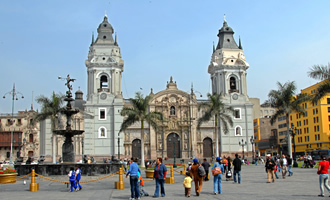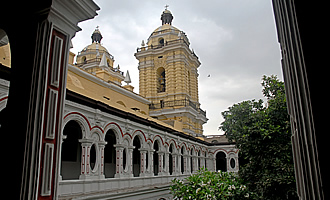LIMA

Plaza de Armas

Monistary

Cathedral of Lima
Lima, located on the central western coast and is shrouded in a misty coastal fog for much of the year. There is a sunny period, December through April, when many coast and highland people go to the beach. Despite the unimpressive landscape; the friendly people, important historical sites, quality museums, and variety of dining and entertainment establishments make Lima a very interesting place to visit.
Festivities can be explored year-round in Lima. The Lord of the Miracles (Senor de los Milagros), the patron saint of Lima, is celebrated in October with a series of street parades that include a life-size replica of Jesus carried on an elaborate adorned altar. The faithful followers are adorned in purple robes and the entire reverent, yet festive, occasion is accompanied by music, singing, the ringing of ceremonial bells and the burning of incense. October is also the month when the bullfighting season begins. The best bullfighters of the world come to compete for the Escapulario de Oro (the gold epaulet) in the Plaza de Acho ring. Other celebrations throughout the year include a wine harvest festival in March, and the Feria del Pacifico international fair in November.
The Plaza de Armas is a great starting point for exploring Lima. Stand in the middle of this spacious and handsome square, by the 17th-century bronze fountain, and you are at the historic heart of the city. On the north side is the Government Palace, which was completed in 1938, and suffers from the past of Peru’s dictators of the time for grandiose French baroque. On weekdays at 12:45 pm, you can see the changing of the guard. The eastern side of the square is dominated by the cathedral, which was reconstructed many times due to earthquakes. Inside, the cathedral is large and unusually austere. Opposite the cathedral is the Municiplidad de Lima, or town hall. The pleasant interior includes a fine library. Next to it on the square is the headquarters of the Club de la Union, a lunchtime mixture of politicians and professionals.
Lima has many choices of museums to visit. The Museum of Anthropology and Archaeology in the Plaza Bolivar is one of the most interesting museums in South America, with a superb collection of pottery and textiles from all the main cultures of ancient Peru. The Museum of the Republic, contains exhibits from the colonial and independence periods. The National Museum, opened in 1990, in a neo-brutalist mausoleum on Av Javier Prado Oeste in San Borja. The museum contains impressive mock-ups of pre-Columbian archaeological sites, and an ingenious replica of the Chavin stela, a massive carved stone idol. The Gold Museum contains a private collection with some fine items and artifacts. The Museum of the Inquisition, next to the Congress in the city center, is in the building where generations of supposed heretics were tortured and tied. The stocks in the underground dungeons and torture chambers are originals.
The business district of San Isidro and Miraflores are the main areas for shopping, restaurants, cafes and theatres. At the top end of Av. Larco is the Parque Kennedy, where artists sell paintings during the weekend. Next to the Pacifico Cinima is the Café Haiti, a prime spot for people-watching. Around the corner in Ricardo Palma, is the more upmarket Vivaldi Café. Walking down Diagonal you will find firstly great imported export-quality Peruvian coffee in the highly trendy Café Café and a little further on is a side street crammed with pizzerias with open-air tables. A cobbled road leads down a gully to the Costa Verde, as the sweep of beaches is called.
Lima is also the the home of the famous Mistura Food Festival held every year in September. Click the Mistura Food Festival Link for more information.
Travel Connections provides breakfast and dinner and all transfers during their tours.

